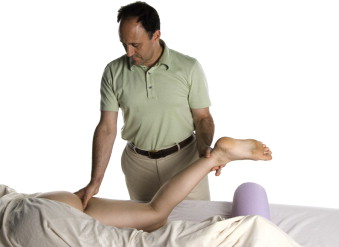Signs and symptoms:
The most common symptom of a hamstring strain is pain in the posterior thigh at the site of the strain. Pain is usually sharp when the injury is acute, and transitions to being more dull as time passes from the injury. The strained area is tender to palpation. Most often the strain occurs proximally near the attachment on the ischial tuberosity, however it can occur farther distally in the musculature. If the strain is acute, swelling will also be present. Depending upon the severity, ecchymosis (black and blue bruising) may also be visible due to the pooled blood under the skin. As time passes, due to the effect of gravity, the pooled blood will drop, causing the bruising to be visible more inferiorly in the thigh. Because there is tearing of muscle tissue, contracting hamstring musculature in an attempt to extend the thigh or flex the leg, especially against resistance, will result in pain. Stretching the hamstring musculature by moving the thigh into flexion with the knee joint extended will also likely result in pain.

Palpation of the proximal attachment of the hamstrings at the ischial tuberosity. Permission: Joseph E. Muscolino. The Muscle and Bone Palpation Manual, 2ed (2016), Elsevier.
Swelling and ecchymosis are not present in the chronic phase. Depending on how well the tissue is healed, pain might or might not be present; when present it is usually dull in quality. But it is likely that global tightness of hamstring musculature and/or myofascial trigger points will remain. This will usually result in decreased flexion range of motion of the thigh if the knee joint is extended. If the original strain was sufficiently severe, the client/patient might have a defect in the muscle that feels like an indentation where the strain occurred. Adjacent to this indentation there will often be a palpable lump created by bunching of the disrupted fibers as well as scar tissue (“fuzz” in the parlance of educator Gil Hedley) that has built up.
If hamstring musculature is tight enough, it can affect the postural balance of the thigh and/or pelvis. The effect of tight hamstring musculature pulling upon the pelvis is posterior tilt of the pelvis, which may then lead to a rounded low back (lumbar spine) posture.
Assessment/Diagnosis:
Assessment/diagnosis of a hamstring strain can be reasoned from the mechanics of the injury. In the acute stage, the location of the client’s/patient’s pain will indicate the area of strain, and palpation will further elicit pain. Swelling will likely be palpable and visible. If the strain is marked or severe, palpation may also reveal a defect/indentation in the hamstring musculature where the tearing occurred. If the tear is a complete rupture from the ischial tuberosity, the hamstring fibers will ball up farther distally in the thigh.
Active hip joint extension and knee joint flexion ranges of motion and manual resistance to these joint actions will increase the client’s/patient’s pain because these joint actions engage the injured hamstring musculature. Active or passive hip joint flexion with the knee joint extended will increase pain because it stretches the torn hamstring muscle fibers. Gait is often impaired due to pain.
During the chronic stage, assessment of a hamstring strain is done by palpating for global tightness of hamstring musculature, myofascial trigger points, and/or fascial adhesions. Stretching the hamstring musculature by flexing the hip joint with the knee joint extended will usually result in decreased range of motion. If the hamstring musculature is globally tight, postural exam might reveal posterior tilt of the pelvis.
Differential assessment:
Assessment of a hamstring strain is fairly straightforward. However, it is important to be sure that the posterior thigh pain is not being caused by sciatica, whether the sciatica is due to nerve root compression at the lumbar spine or piriformis syndrome. Differential assessment should also be aimed at discerning simple global tightness, myofascial trigger points, or fascial adhesions within the hamstring musculature that might exist without the provocation of a hamstring strain.



